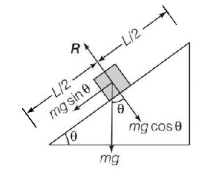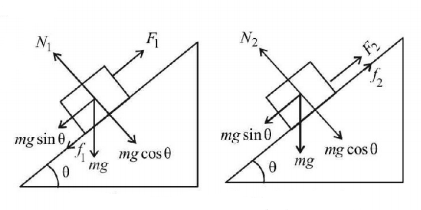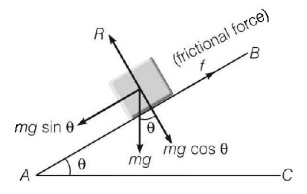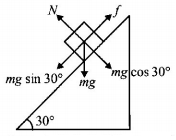1. The upper half of an inclined plane of inclination $$\theta $$ is perfectly smooth while lower half is rough. A block starting from rest at the top of the plane will again come to rest at the bottom, if the coefficient of friction between the block and lower half of the plane is given by
A
$$\mu = \frac{1}{{\tan \theta }}$$
B
$$\mu = \frac{2}{{\tan \theta }}$$
C
$$\mu = 2\tan \theta $$
D
$$\mu = \tan \theta $$
Answer :
$$\mu = 2\tan \theta $$
2. The minimum force required to start pushing a body up rough (frictional coefficient $$\mu $$) inclined plane is $${F_1}$$ while the minimum force needed to prevent it from sliding down is $${F_2}.$$ If the inclined plane makes an angle $$\theta $$ from the horizontal such that $$\tan \theta = 2\mu $$ then the ratio $$\frac{{{F_1}}}{{{F_2}}}$$ is
A
1
B
2
C
3
D
4
Answer :
3
3.
A block of mass $$m = 2\,kg$$ is placed on a plank of mass $$M = 10\,kg$$ which is placed on a smooth horizontal plane. The coefficient of friction between the block and the plank is $$\mu = \frac{1}{3}.$$ If a horizontal force $$F$$ is applied on the plank, then find the maximum value of $$F$$ for which the block and the plank move together. (Take $$g = 10\,m/{s^2}$$ )

A
$$30\,N$$
B
$$40\,N$$
C
$$120\,N$$
D
None of the above
Answer :
$$30\,N$$
4.
An insect crawls up a hemispherical surface very slowly (see fig.). The coefficient of friction between the insect and the surface is $$\frac{1}{3}.$$ If the line joining the center of the hemispherical surface to the insect makes an angle $$\alpha $$ with the vertical, the maximum possible value of $$\alpha $$ is given by

A
$$\cot \alpha = 3$$
B
$$\tan \alpha = 3$$
C
$$\sec \alpha = 3$$
D
$${\text{cosec}}\alpha = 3$$
Answer :
$$\cot \alpha = 3$$
5. A block has been placed on an inclined plane with the slope angle $$\theta ,$$ block slides down the plane at constant speed. The coefficient of kinetic friction is equal to
A
$$\sin \theta $$
B
$$\cos \theta $$
C
$$g$$
D
$$\tan \theta $$
Answer :
$$\tan \theta $$
6.
The coefficient of static friction, $${\mu _s},$$ between block $$A$$ of mass $$2\,kg$$ and the table as shown in the figure, is 0.2. What would be the maximum mass value of block $$B,$$ so that the two blocks do not move? The string and the pulley are assumed to be smooth and massless $$\left( {g = 10\,m/{s^2}} \right)$$

A
$$2.0\,kg$$
B
$$4.0\,kg$$
C
$$0.2\,kg$$
D
$$0.4\,kg$$
Answer :
$$0.4\,kg$$
7.
The two blocks, $$m = 10\,kg$$ and $$M = 50\,kg$$ are free to move as shown. The coefficient of static friction between the blocks is 0.5 and there is no friction between $$M$$ and the ground. A minimum horizontal force $$F$$ is applied to hold $$m$$ against $$M$$ that is equal to

A
$$100\,N$$
B
$$50\,N$$
C
$$240\,N$$
D
$$180\,N$$
Answer :
$$240\,N$$
8. A block of mass $$2kg$$ rests on a rough inclined plane making an angle of $${30^ \circ }$$ with the horizontal. The coefficient of static friction between the block and the plane is 0.7. The frictional force on the block is
A
$$9.8N$$
B
$$0.7 \times 9.8 \times \sqrt 3 N$$
C
$$9.8 \times \sqrt 3 N$$
D
$$0.7 \times 9.8N$$
Answer :
$$9.8N$$
9.
A block rests on a rough inclined plane making an angle of $${30^ \circ }$$ with the horizontal. The coefficient of static friction between the block and the plane is 0.8. If the frictional force on the block is $$10N,$$ the mass of the block (in $$kg$$) is
(take $$g = 10m/{s^2}$$ )
A
1.6
B
4.0
C
2.0
D
2.5
Answer :
2.0
10.
A block $$B$$ is pushed momentarily along a horizontal surface with an initial velocity $$v.$$ If $$\mu $$ is the coefficient of sliding friction between $$B$$ and the surface, block $$B$$ will come to rest after a time

A
$$\frac{v}{{g\mu }}$$
B
$$\frac{{g\mu }}{v}$$
C
$$\frac{g}{v}$$
D
$$\frac{v}{g}$$
Answer :
$$\frac{v}{{g\mu }}$$






